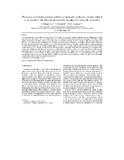Please use this identifier to cite or link to this item:
http://hdl.handle.net/10311/367Full metadata record
| DC Field | Value | Language |
|---|---|---|
| dc.contributor.author | Nijegorodov, N. | |
| dc.contributor.author | Zvolinsky, V. | |
| dc.contributor.author | Luhanga, P.V.C. | |
| dc.date.accessioned | 2009-09-09T12:47:25Z | |
| dc.date.available | 2009-09-09T12:47:25Z | |
| dc.date.issued | 2008 | |
| dc.identifier.citation | Nijegorodov, N. et al (2008) Photonics and photochemical stability of aromatic molecules, family related in -structure but different in planarity, rigidity and molecule symmetry, Journal of Photochemistry and Photobiology A: Chemistry, Vol. 196, No. 2-3, pp. 219-226 | en_US |
| dc.identifier.issn | 1010-6030 | |
| dc.identifier.uri | http://hdl.handle.net/10311/367 | |
| dc.description.abstract | Intramolecular processes and fluorescence properties of 32 specially chosen aromatic molecules, different in degrees of planarity and rigidity, but family related in -structure are experimentally and theoretically (using the PPP-method) studied at room temperature (293 K). The quantum yields of fluorescence , and decay times τf, of deaerated and non-deaerated cyclohexane solutions are measured. The oscillator strength fe, the fluorescence rate constants kf, the natural lifetimes τT o , and the intersystem crossing rate constants kST, are calculated. The investigations showed the following differences in the behaviour of the fluorescence parameters in transition from the non-planar molecule to the planar and more rigid-type: the value of the symmetry line wave-number υ00 (the frequency of the S0→S1 * transition) and the Stokes shift υST, decrease. The oscillator strength and fluorescence constant, normally decrease. The change in the quantum yield of the fluorescence depends upon the changes in the kf and kST values. Furthermore, the intersystem crossing rate constant generally decreases, sometimes very significantly. However, there are some interesting exceptions. For example, the kST value of the non-planar molecule of 9,10-diphenylanthracene is less than the kST value of the planar and very rigid molecule of anthracene. This important phenomenon is explained. The differences of the intramolecular processes of planar and non-planar molecules are discussed. The photochemical stability of planar and non-planar molecules is studied. The effect of planarity, rigidity and molecular symmetry upon laser properties is also traced. | en_US |
| dc.language.iso | en | en_US |
| dc.publisher | Elsevier Science Ltd. www.elsevier.com/locate/jphotochem | en_US |
| dc.subject | Planarity | en_US |
| dc.subject | Rigidity | en_US |
| dc.subject | Fluorescence and laser properties | en_US |
| dc.title | Photonics and photochemical stability of aromatic molecules, family related in -structure but different in planarity, rigidity and molecule symmetry | en_US |
| dc.type | Published Article | en_US |
| Appears in Collections: | Research articles (Dept of Physics) | |
Files in This Item:
| File | Description | Size | Format | |
|---|---|---|---|---|
| Nijegorodov_JPPaC196_2008.pdf | 1.86 MB | Adobe PDF |  View/Open |
Items in DSpace are protected by copyright, with all rights reserved, unless otherwise indicated.
